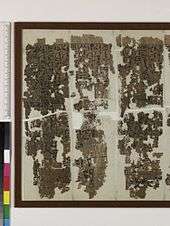Dramatic Ramesseum Papyrus

The Dramatic Ramesseum Papyrus (also known simply as the Ramesseum Papyrus) is the oldest known surviving illustrated papyrus roll. It contains a ceremonial play written to celebrate the accession to the throne of Senusret I of the Twelfth Dynasty and is dated to around 1980 BC. It was discovered in the Ramesseum, from which it gets its name. The text of the roll is in linear hieroglyphs written in narrow, vertical columns. The text occupies the top four-fifths of the scroll and the illustrations the bottom. The scenes are arranged in a manner similar to a modern comic strip with the Pharaoh, in the role of Horus, appearing multiple times. Scenes are divided from each other by vertical lines. The papyrus is now preserved at the British Museum.[1]
References
- ↑ "Papyrus Ramesseum B (the Dramatic Papyrus)". British Museum. Retrieved 2018-03-18.
Weitzmann, Kurt. Illustrations in Roll and Codex. Princeton University Press, 1970.